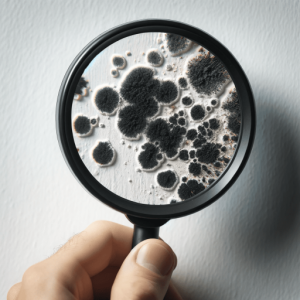Causes of Mould
Mould can easily become a problem indoors. To prevent it, be aware of these common causes:
Flooding during heavy rains
Moisture seeping through walls and under carpets, behind plaster wall cavities and skirting boards and you may not even realise it’s occurring – but if you are aware of this happening call in a professional remediation company. Ensuring that wet carpets are lifted and drying equipment installed, do not attempt to dry down without lifting. Ensure that moisture testing is carried out before reinstalling carpets. Some insurance companies will send out their remediation company but this doesn’t mean that they have the skills or know how to or that they are not doing it for a price – Some insurance companies will not let their remediation companies use dehumidifiers and by doing this they could be playing Russian Roulette with your health.
Burst water pipes
Builders are notorious for looking at these issues and stating that it should be left to dry for a couple of weeks and then they will come back and ascertain if there is any damage. The mould that can build up under kitchen cupboards, behind skirting boards and in wall cavities can and does affect some individuals. As with any water damage contact a local professional and if you are not sure if what they are doing is correct feel free to contact us and we can outline what we think they should do to ensure no health issues develop.
Overflows
Overflows from washing machines baths or fish tanks should be dealt with immediately by a professional as without be addressed adequately mould in some form will develop
Back up from drains
If you have a backup from drain or floor waste inside the house don’t let anyone just clean and dry carpets- remember if it came from a floor waste it is contaminated by the same things which go down a toilet, remove and dispose of affected carpets, remove skirting boards and if it affected wall plaster remove the affected areas immediately then dry down professionally.
Rising Damp
Rising Damp or Poor drainage allows water penetration under the house or building- not everyone is away. Still, moisture under a house will cause humidity issues within a building, leading eventually to growth in bacterial and fungal contamination. So addressing subfloor drainage issues is extremely important to ensure you have a healthy building. Depending on the site sub floor mechanical ventilation is an alternative direction for removing evaporated moisture
Leaking roofs
Leaking roofs will not only produce brown marks on ceiling plaster but will result in fungal growth within the plaster. If you have insulation in the roof cavity it will hold water for a lot longer, in turn increasing the resultant fungal and bacterial growth
Condensation
Condensation in roof voids or wall cavities – as with any ingress of water on an ongoing basis be aware that wall cavities which remain wet or continue to be wet for a short period will facilitate a fungal growth environment due to moist vapour pressure within the wall cavity the same will occur in roof cavities.
Humidifiers
Humidifiers in baby’s rooms-the drier a room the healthier the occupants will be so be aware of putting humidifiers into baby’s room without some sort of dehumidifier – in other words, don’t install a humidifier and create condensation problems which may lead to fungal contamination
Wet clothing
Wet clothing not being dried – water from washing hung in a house without ventilation will increase the humidity in a house which is the environment that fungi like to grow in
Carpet Cleaning
Cleaning of carpets where carpets are left wet for days – numerous cowboys can do more damage to your health by leaving your carpets wet for days – ensure you contact your local association and here in Australia, it is NUCCRA who can direct you to someone qualified to clean your carpets without promoting mould growth
Clothes dryers
Clothes dryers produce humidity if not exhausted to the outside air – this is an issue where there is little or no ventilation to remove the humid air while the unit is running
Gas Heaters
Unventilated gas heaters (No Flue) also increase humidity eventually leading to condensation on colder surfaces and the result can be detrimental to your health
Bathroom Ventilation
Bathrooms which are not mechanically ventilated develop mould especially in winter when showering becomes longer and hotter
Remember moisture and humidity in any occupied space will eventually lead to various forms of indoor environmental contamination – in the USA they refer to that as Sick Building Syndrome don’t let your family or staff be exposed to these forms of potential dangers.
Leaking Showers
Leaking Showers will often go unnoticed as not everyone goes under a building to ensure it is all dry – the water can affect the upstairs wall cavities and actual flooring- and the fungal and bacterial growth can produce various chemicals which have been associated with health issues.
Remember moisture and humidity in any occupied space will eventually lead to various forms of indoor environmental contamination – in the USA they refer to that as Sick Building Syndrome don’t let your family or staff be exposed to these forms of potential dangers.


